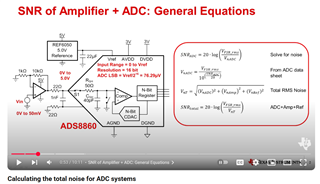Other Parts Discussed in Thread: ADS8860
Tool/software:
Hello, I am looking for a clarification on calculation that TI provides in training
In below noise analysis Video, input is a step response to the Opamp and ADC.
My understanding is that SNR from ADC datasheet is based on AC input parameter.
In the calculation, SNR is being used to calculate vrms noise from ADC whereas input to the system is DC.
Could you please clarify why this is a proper way of calculating the total noise? I thought SNR could be ignored in the total noise calculation in the case of where input is DC.


